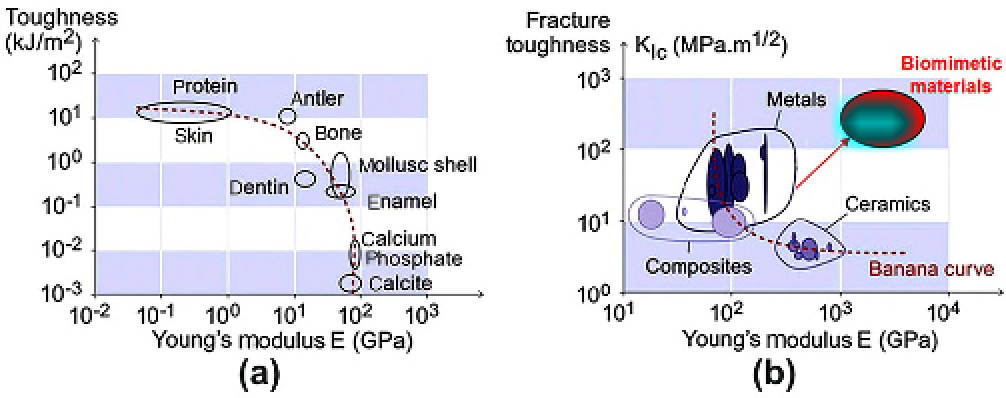Biomedical Engineering Reference
In-Depth Information
materials with distinct and complementary
mechanical properties, leading to hybrid materi-
als. Carbon-fiber-reinforced polymers enter this
category.
The concept of hybrid materials has been
elegantly described by Ashby's equation: hybrid
material
=
material A
+
material B
+
configu-
ration
+
scale
[1, 3]
, i.e., combination of materials
A and B (or more materials) in a controlled
shape, configuration, and scale. A or B can be
theoretically any material, including a gas or
liquid (for the case of cellular solids). Hybrid
materials are powerful alternatives to traditional
monolithic materials and offer a promising
pathway to push the property envelope of tra-
ditional materials. Cellular materials with re-
entrant cells
[4]
and anisotropic fibrous
composites
[5, 6]
can display unusual properties
such as negative Poisson's ratio or negative coef-
ficient of thermal expansion
[7]
.
Hybrid materials are abundant in nature,
with mollusk shells, bone, tooth, tendon, and
glass-sponge skeleton as only a few examples
of such materials. In addition to specific chem-
istries, the structures of many of these hierar-
chical materials display specific features over
distinct length scales. These materials boast
remarkable combinations of properties, in some
cases unmatched in engineering materials. For
example, mollusk shell and bone are stiff and
at the same time tough and flaw-tolerant,
meaning that their strength is not compromised
by the presence of initial flaws (
Figure 3.1
a).
These attributes arise due to the combination
of the high strength of inorganic minerals and
the ductility of organic macromolecules through
specific architectures at different length scales
[8]
. In contrast, hard and stiff engineering
materials like ceramics usually display low lev-
els of toughness, and tough flaw-tolerant mate-
rials like metals are not usually very stiff
(
Figure 3.1
b).
In addition to attractive combinations of
structural properties, natural composites such
as bone possess remarkable capabilities such as
self-healing, damage sensing, and self-repair;
see Chapter 13 on self-organization, self-sealing,
and self-healing in many natural systems. It has
therefore become very attractive to fabricate
materials that duplicate the structure and
mechanics of these natural materials, in line
with a paradigm called
biomimetics
[2, 9, 10]
.
Natural composites are composed of miner-
als and polymers arranged in intricate, compact
structures. The hard inorganic minerals come in
the form of inclusions of finite size embedded in
a matrix of organic polymers. The organic poly-
mers can be seen as interfaces between the hard
FIGURE 3.1
Stiffness-toughness charts for (a) biological materials and (b) engineering materials. Adapted from Ref.
40
.


